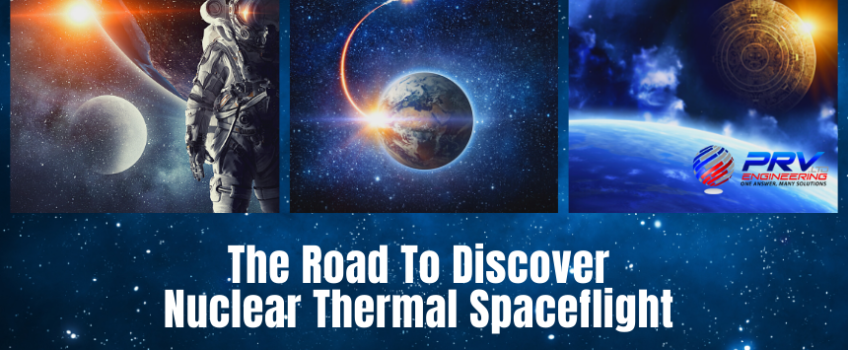
The journey to Mars is a long one, but what if we can cut it by half or explore our galaxy further than ever? The only way to achieve that is nuclear thermal spaceflight which is much closer than many might realise. With advances in technology and more funding for aerospace R&D, we are getting closer to faster space travel.
The Road To Discover Nuclear Thermal Spaceflight
Nuclear thermal spaceflight is not a new concept but it’s certainly advancing at a rapid pace. Fact is, Stanisław Ulam and Frederic de Hoffmann already contemplated the idea of controlling the power of nuclear explosions to launch space vehicles in 1944.
After the Second World War, the U.S. military started developing intercontinental ballistic missiles (ICBM) based on the German V-2 rocket designs. They also designed large rockets to carry nuclear warheads with nuclear-powered propulsion engines.
There were secret ground-breaking reports in 1946 as part of the NEPA project that identified a reactor engine that involved heated a fluid of low molecular weight using a nuclear reactor. This was the most promising form of nuclear propulsion, although several technical issues required further investigation.
The Realisation Of Interplanetary Travel
Just one year later, in May 1947, scientist Hsue-Shen Tsien presented research on cutting edge “thermal jets”. They would be powered by a graphite-moderated nuclear reactor at the Nuclear Science and Engineering Seminars LIV, which the Massachusetts Institute of Technology had organised.
Then, in 1948 and 1949, physicist Leslie Shepherd and rocket scientist Val Cleaver produced ground-breaking research. The papers examined nuclear-thermal and nuclear-electric propulsion showing how they could apply this technology to interplanetary travel.
As a result of their continued efforts, and that of many other scientists since, we are closer to NTP (Nuclear Thermal Propulsion) than ever. This means nuclear thermal spaceflight is now within reach and the latest development is a promising one.
New DARPA Contract For Nuclear Thermal Spaceflight
DARPA has a new programme called DRACO (Demonstration Rocket for Agile Cislunar Operations) announcing its three prime contractors are General Atomics, Blue Origin, and Lockheed Martin. With a brain trust of that magnitude, the possibilities and potential for nuclear thermal spaceflight seem better than ever.
The DRACO programme aims to demonstrate a nuclear thermal propulsion (NTP) system above low Earth orbit in 2025. If the mission is a success, DARPA would have built the very first rocket using technology for nuclear thermal spaceflight. The benefits of NTP is incredible as it would halve the travel time across the Solar System which could open the door to many more interplanetary travel opportunities.
The Next Generation Of Space Travel
The current limitations of electric and chemical space propulsion systems can’t achieve the speeds required to travel to the distant universe. However, DRACO’s nuclear thermal propulsion system could change everything. It can achieve high thrust-to-weight ratios comparable to in-space chemical propulsion and match the high propellant efficiency of electric systems.
The Sierra Nevada Corporation is working with General Atomics on the NTP programme and had the following to say: “NTP offers a high thrust-to-weight ratio around 10,000 times greater than electric propulsion and two to five times greater specific propellant efficiency than chemical propulsion.”
They also confirmed that the nuclear thermal propulsion system will use a liquid hydrogen propellant heated by a nuclear fission reactor. This will offer twice the amount of energy output of today’s most advanced liquid propellant rocket engine.
To Mars And Back Using Nuclear Thermal Spaceflight
The DRACO programme might currently be focused on fast travel to the Moon but it would most likely be developed to reach Mars and beyond. It’s now in Phase 1 which will last 18 months where the contractors will design the nuclear thermal propulsion reactor and propulsion subsystem concept.
According to DARPA, they will also produce an “Operational System (OS) spacecraft concept to meet mission objectives and design a Demonstration System (DS) spacecraft concept.” Maj Nathan Greiner, USAF, program manager for DRACO stated that the “first phase of the DRACO program is a risk reduction effort that will enable us to sprint toward an on-orbit demonstration in later phases.”
Conclusion
If all goes to plan, Phase 1 will include follow-up phases which will involve the fabrication and on-orbit demonstration of the rocket responsible for nuclear thermal spaceflight. As promising as this may be, DARPA isn’t the only organisation working to improve the efficiency and speed of space travel using nuclear propulsion.
In March 2021, radiation detection firm U.S. Nuclear Corp asked NASA to help develop a nuclear fusion-powered spacecraft. It would initially be used for crewed flights to Mars but the possibilities are endless. The UK Space Agency is also collaborating with Rolls Royce to develop a nuclear propulsion system that could halve the travel time to Mars.
Since PRV Engineering works closely with organisations in the aerospace sector, we are keeping a keen eye on these developments. For more information about what we do, please visit our website or give us a call on 01495 769697.


 Mail:
Mail: 



